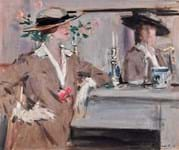
Although the firm has sold a handful of more expensive Chinese objects, including a £650,000 Qianlong blue and white vase in 2016, Hanson described the discovery of two of the celebrated botanical studies c.1907-10 as his “most significant find ever”.
Only about 80 Fabergé flowers, inspired by Chinese art, are known. According to Franz Birbaum, Fabergé’s senior designer, the genre came to Peter Carl Fabergé’s attention when the firm was asked to repair a group of hardstone chrysanthemums made for the Qing court.
The 6in (15cm) high duo, the property of a distinguished lady, depict a barberry bush with purpurine berries and jade leaves in a carved rock crystal vase, and a morning glory blossom of enameled gold and diamond flowers in a jade jardinière with an aventurine quartz stand. Neither model was in perfect condition with both suffering some losses.
On the evening of June 11 at Hansons’ London sale venue, the Normansfield Theatre in Teddington, the two lots fetched a combined £340,000 (plus 20% premium) with both flowers knocked down to the same private buyer on the phone. The morning glory sold for £180,000 and the barberry bush fetched £160,000.
While a Fabergé flower group recently received a valuation of £1m on BBC’s Antiques Roadshow, auction precedents have been more modest. A spray of Fabergé buttercups fetched £350,000 at Sotheby’s London in 2013.
However, last year, studies of enameled cornflowers and turquoise forget-me-nots went unsold against low estimates of £180,000 and £250,000 respectively.














